
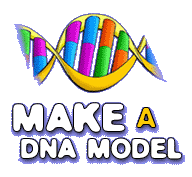
Do the DNA Twist!
What do a person, a daisy, a fish, and a beetle have in common? They're all made of cells ! That's right, even YOU are made of trillions of tiny cells.

But if all living things are made of cells, what makes each one unique? You're different from a snail, a tree, and even your best friend because of your DNA , the unique genetic code found in every cell in your body. You can't see DNA's structure (even with a powerful microscope), but you'll make a model of it in this activity.
WHAT YOU'LL NEED
THE MATERIALS
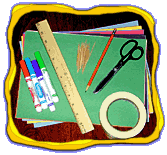
Some colored paper (thicker paper is better)
Scissors
A pencil
A box of toothpicks (not the colored ones)
Magic markers
A ruler
String or masking tape
SAFETY TIPS
- Toothpicks can be very sharp, so be careful poking those holes!
- As you poke each toothpick through the paper, keep you fingers away from the hole.
- Don't poke any holes while the paper is on your lap.
SOLVING THE PUZZLE
A strand of DNA is much, much thinner than a human hair–you can't even see it with a microscope that makes things look almost a million times bigger. So how do we know what the structure of DNA is like? A scientist named Rosalind Franklin shot X-rays at blobs of DNA. She took a picture of the pattern the X-rays made. When two other scientists named James Watson and Francis Crick looked at her picture, it gave them an idea. They used Tinkertoy-like models to show that DNA is shaped like a twisted ladder. This shape is called a double helix.
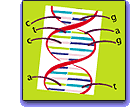
Watson and Crick also figured out that DNA is made of chemicals called bases . The "steps" of the DNA ladder are pairs of bases:
adenine (A) and thymine (T) or cytosine (C) and guanine (G).
The order of the base pairs holds the specials code for how living things grow and develop.
WHERE'S THE DNA?
This DNA stuff sounds cool, but where do you find it? Okay, follow this:

Every living thing is made of cells.

Most plant and animal cells have a nucleus. The nucleus tells the cell what to do.

Inside the nucleus are chromosomes.

Chromosomes are made of long strands of tightly coiled DNA. (If you stretched out the DNA from a human cell, it would be about six feet long!)
DNA holds all the information that gives living things their unique traits.
WHAT TO DO
Follow these steps to make your very own 3-D model of DNA. Remember, DNA is shaped like a double helix or twisted ladder.

First, make the sides of the ladder. To do this, cut two strips of colored paper that are at least two feet long and about one inch wide. (If your paper's not long enough, tape a couple of strips together.)
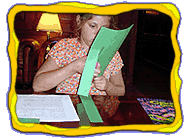

Use a pencil and a ruler to mark each inch along one strip.
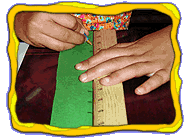

Next, make the steps or rungs of the ladder. In DNA, these steps are made of four bases : adenine (A), thymine (T), cytosine (C), and guanine (G). Choose four colors from your markers to represent the four bases. Write the colors you choose for each base here:
A: __________ T: __________
C: __________ G: __________
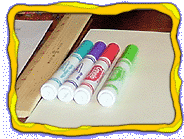

Take 10 toothpicks. For each one, color half the toothpick the color you chose for A. Color the other half the color you chose for T. Take ten more toothpicks and do the same thing with the colors you chose for C and G. (It's important that A is always paired with T and C is always paired with G.)
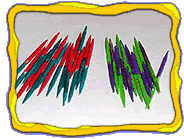

Now construct your double helix! Grab both strips of paper, put one on top of the other, and tape them together at each end.
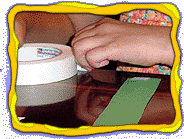

Using the pencil marks as a guide, poke a toothpick through the middle of the strips at every inch. You can add toothpicks in any order you want.
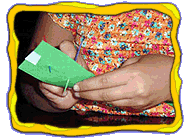

Keep going until your strips are filled up. Be sure to leave some room at the ends of the strips. Make sure all the toothpicks are pushed halfway through the holes.
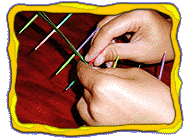

Gently spread the two strips apart until your model looks like a ladder. This is what DNA would look like if it weren't twisted. (Hint: If any toothpicks fall out, put a drop of glue on the hole, stick the toothpick back in, and let the glue dry. You could also wrap a piece of tape around the toothpick.)
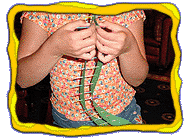

Now for the twist: Tape one end of your model to a wall or wherever you want to hang your DNA model. (Make sure the place you choose is okay with your parents.)
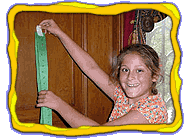

Then, carefully holding the DNA model, twist it at least once around until it looks like a double spiral. Tape the other end to a flat surface. Congratulations - you've done the DNA twist!
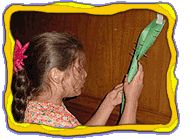
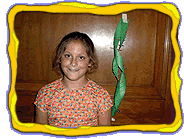
MORE THINGS TO TRY
- Experiment by using different materials to see what works best, like Popsicle sticks or cotton swabs for the steps and pipe cleaners or flexible wire for the sides.
- Make a DNA mobile. Use a flexible material (like pipe cleaners or wire) that will twist without being taped down. Tie some string to the top step and hang it in your room.
- DNA is very, very long and curves in all directions. First, see how long you can make your DNA model. Then see if you can make your double helix turn and curve in different directions.
Image Credits:
Illustrations: Daryl Collins




 Biodiversity
Biodiversity
 Brain
Brain
 Genetics
Genetics
 Marine BiOLogy
Marine BiOLogy
 MicrobiOLogy
MicrobiOLogy
 PaleontOLogy
PaleontOLogy
 ZoOLogy
ZoOLogy
 AnthropOLogy
AnthropOLogy
 ArchaeOLogy
ArchaeOLogy
 Astronomy
Astronomy
 Climate Change
Climate Change
 Earth
Earth
 Physics
Physics
 Water
Water
